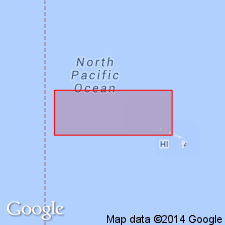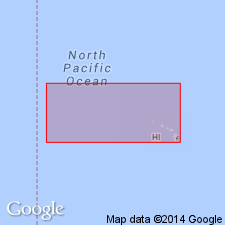
- Usage in publication:
-
- Tantalus basalt*
- Modifications:
-
- Named
- Dominant lithology:
-
- Basalt
- AAPG geologic province:
-
- Oahu
Summary:
Named for occurrence at Tantalus Peak (Puu Ohio). Also occurs in Pauoa Valley [Honolulu 7.5' quad] Island of Oahu. Included in upper part of Honolulu volcanic series. Composed of nephelite-melilite basalt with thick mantle of clinker and balls. Is as much as 100 ft thick. Unconformably overlies Koolau volcanic series and older alluvium. Probably erupted at same time as Sugar Loaf basalt. Assigned latest Pleistocene or Recent age.
Source: GNU records (USGS DDS-6; Menlo GNULEX).

- Usage in publication:
-
- Tantalus basalt*
- Modifications:
-
- Overview
- AAPG geologic province:
-
- Oahu
Summary:
Cinder and clinker in Pauoa Valley below source cone, Tantalus, are 100 to 300 ft thick. Maximum thickness of massive phase of lava is 40 ft. Covers area about 0.3 sq mi in valley on south side of Koolau Range 11 mi west of Makapuu Head. No fossils. Probably simultaneous eruption with Sugar Loaf basalt. Later than plus 25 ft (Waimanalo) stand of sea. Assigned latest Pleistocene or Recent age.
Source: GNU records (USGS DDS-6; Menlo GNULEX).

- Usage in publication:
-
- Tantalus Basalt†
- Modifications:
-
- Abandoned
- AAPG geologic province:
-
- Oahu
Summary:
Tantalus Basalt (Stearns, IN Stearns and Vaksvik, 1935) abandoned as formally named unit and called Tantalus flow (and associated cinder cone and ash deposits), informal unit of Honolulu Volcanics.
Source: GNU records (USGS DDS-6; Menlo GNULEX).
For more information, please contact Nancy Stamm, Geologic Names Committee Secretary.
Asterisk (*) indicates published by U.S. Geological Survey authors.
"No current usage" (†) implies that a name has been abandoned or has fallen into disuse. Former usage and, if known, replacement name given in parentheses ( ).
Slash (/) indicates name conflicts with nomenclatural guidelines (CSN, 1933; ACSN, 1961, 1970; NACSN, 1983, 2005, 2021). May be explained within brackets ([ ]).

